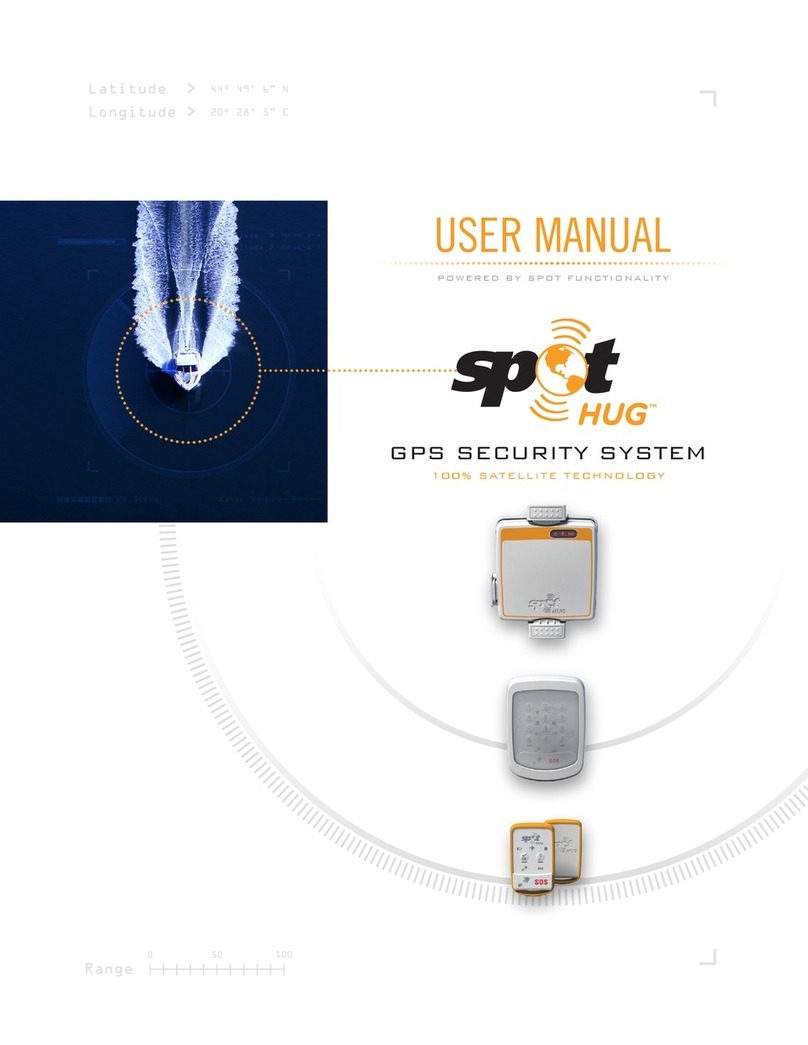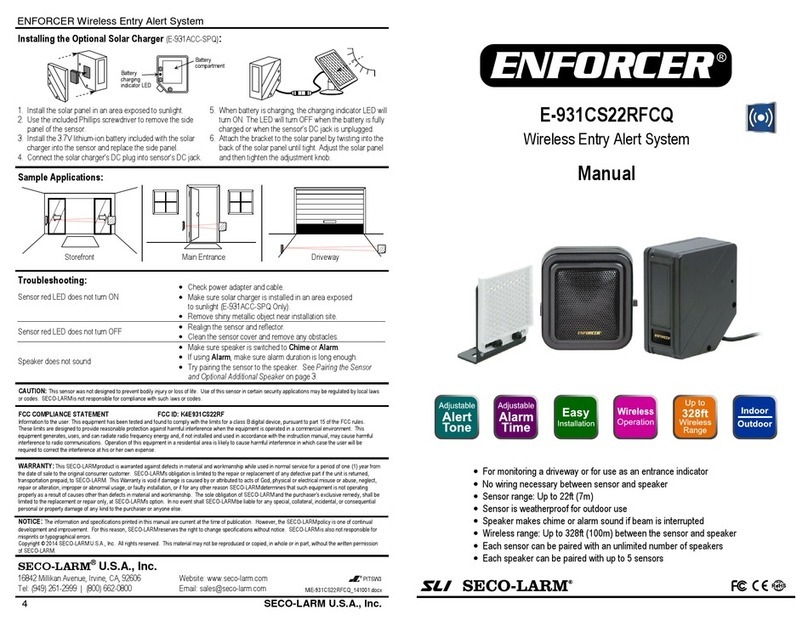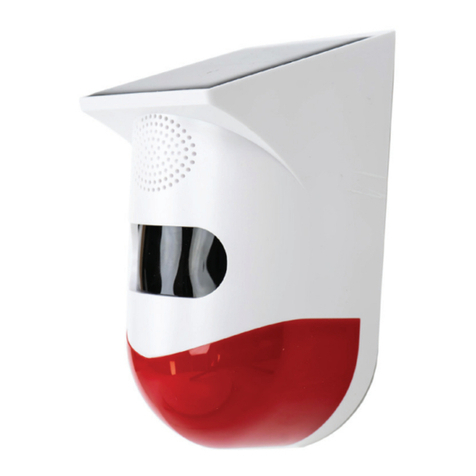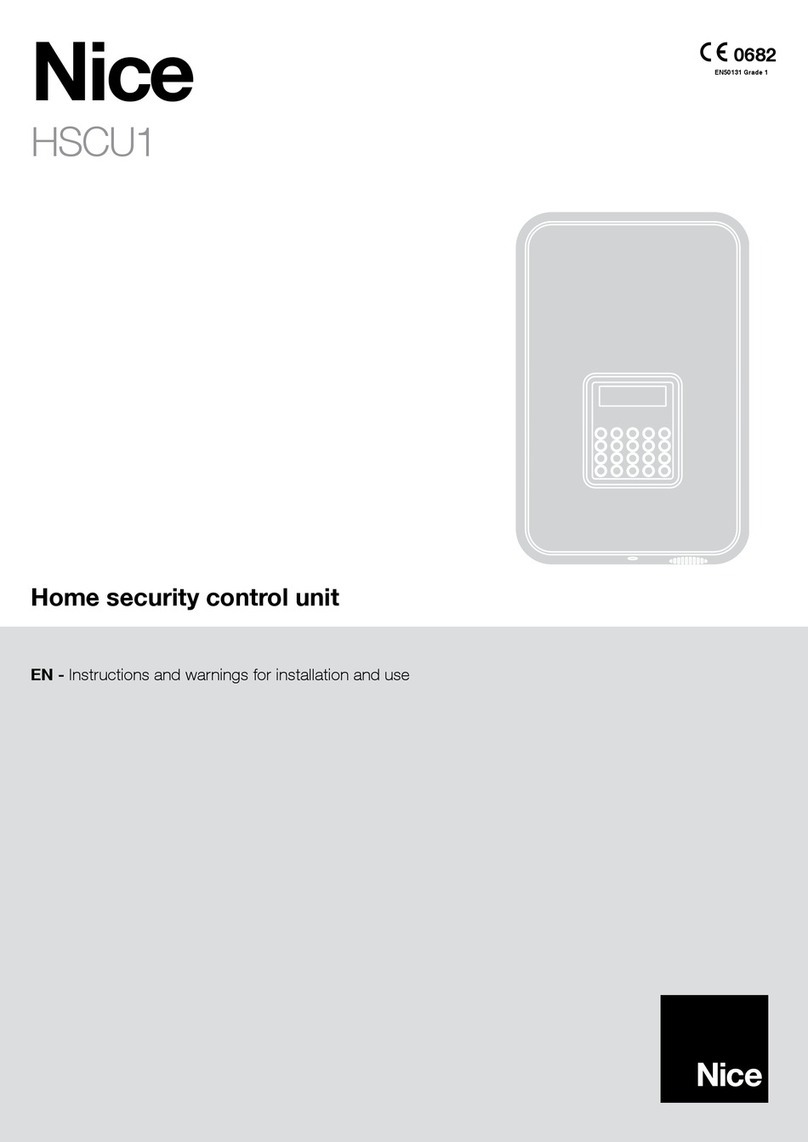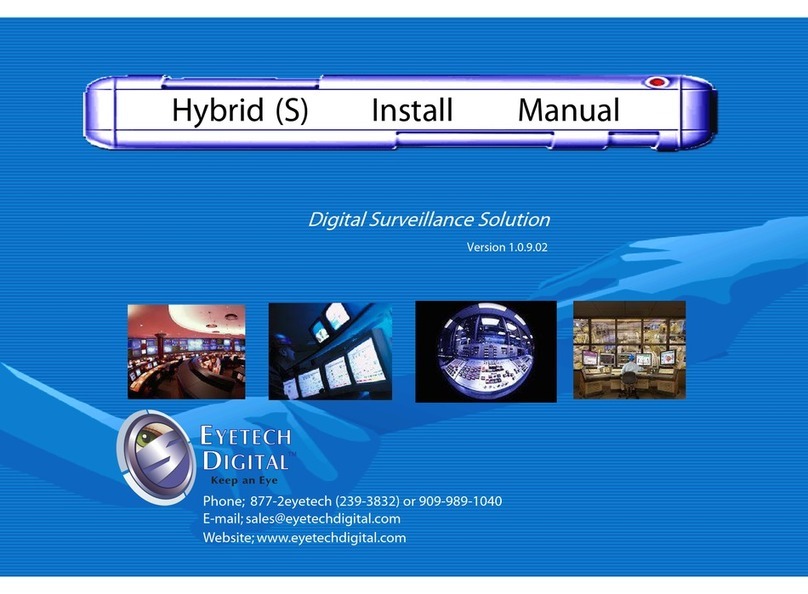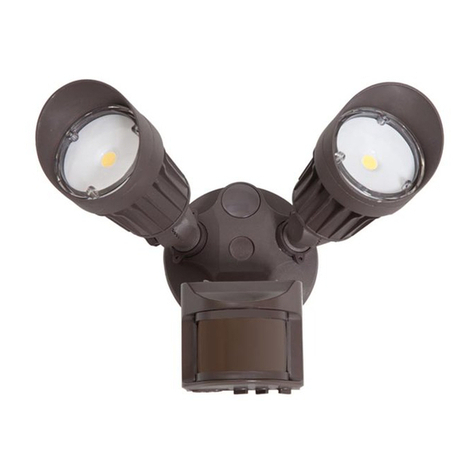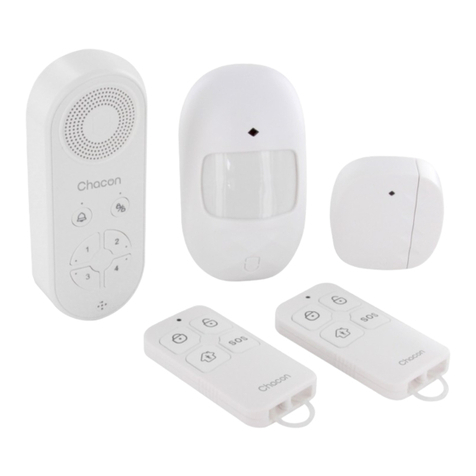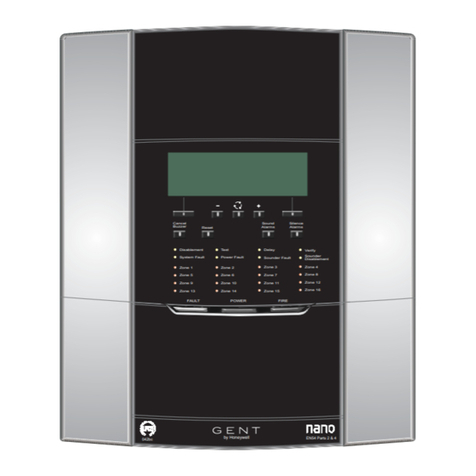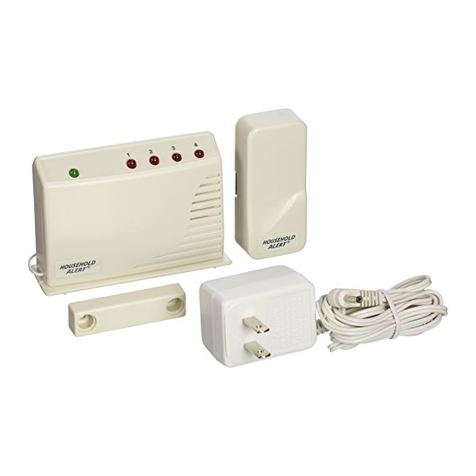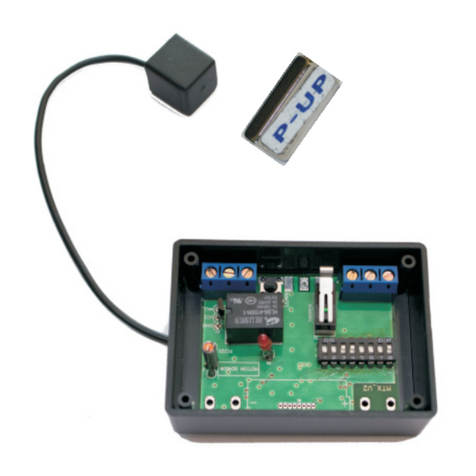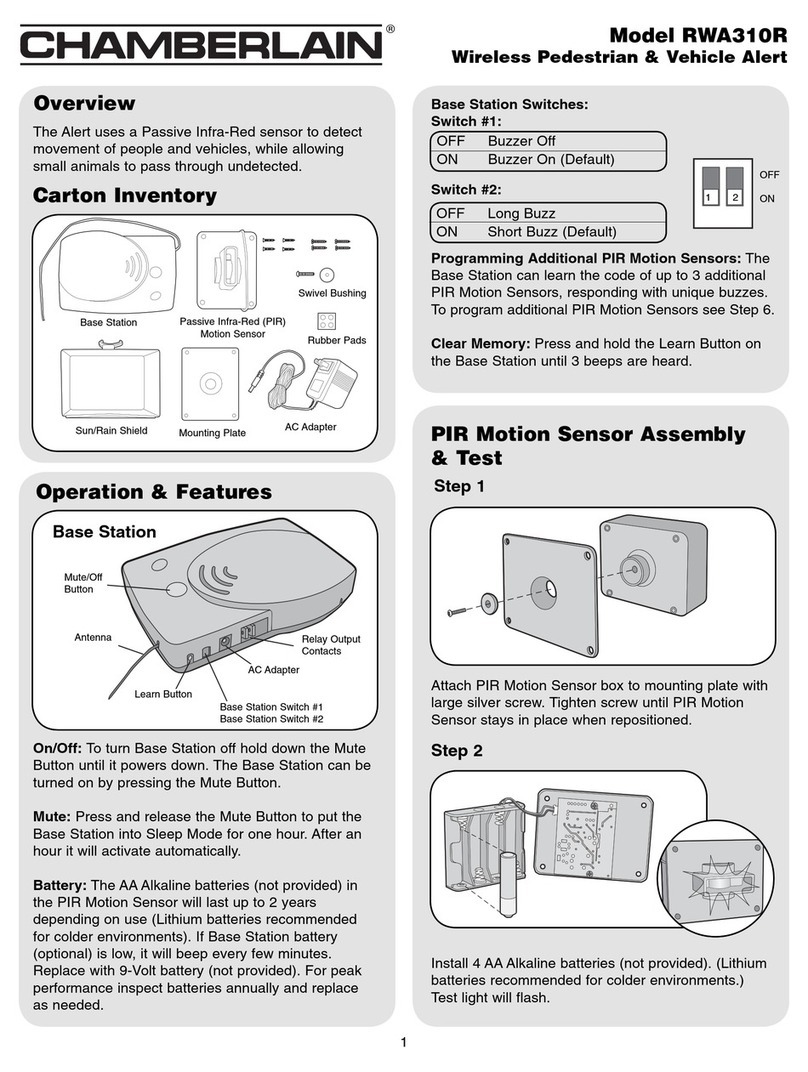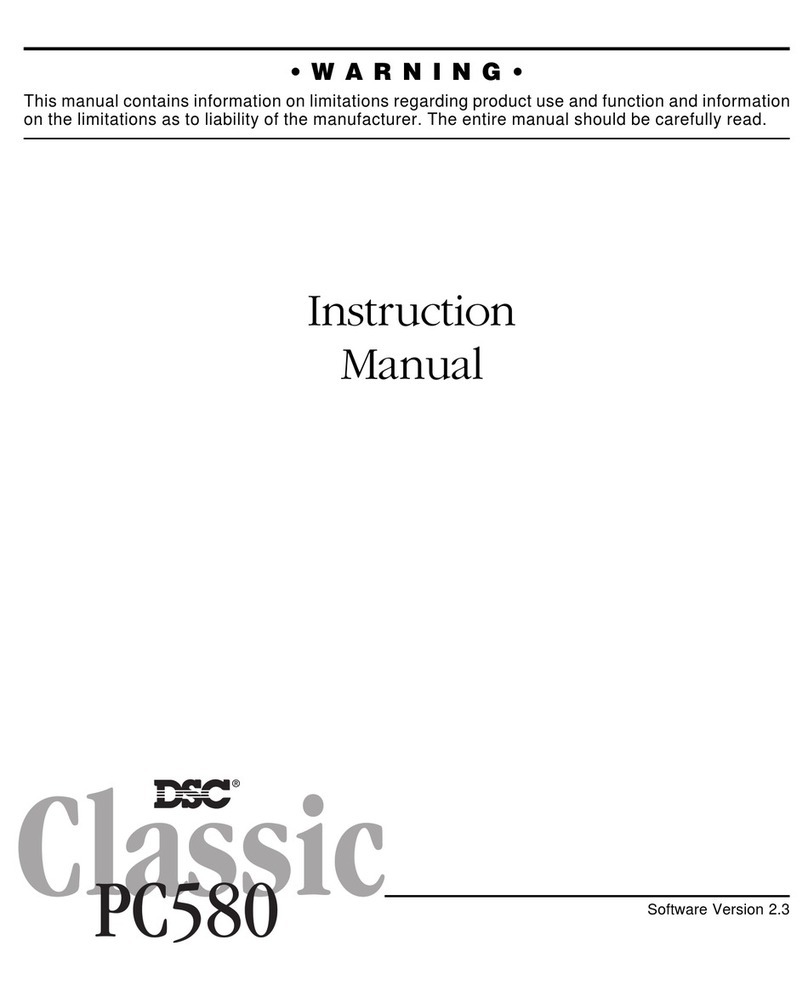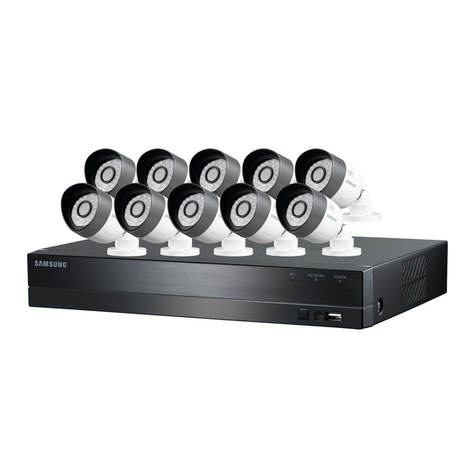Spot Hug GPS SECURITY SYSTEM User manual

USER MANUAL
GPS Security SyStem
100% Satellite technoloGy
powered by spot functionality

SPOT HUG USER MANUAL 2
Welcome ..............................................................3
Key Terminology ...................................................4
How HUG Works ...................................................5
Getting Started ...................................................6
Initial System Setup/Test ...................................12
Installation of Tracker and Keypad ....................15
Using SPOT HUG ................................................18
How the LEDs Blink ............................................23
Keypad Functions ..............................................26
Care, Support and Specifications ......................27
Warranty and FCC/IC Notice ..............................29
Table of Contents
GPS Security SyStem
100% satellite technology

WELCOME 3
SPOT HUG (HUG) is comprised of three (3) hardware
components to provide an indispensible asset protection
security system.
The core Tracker unit contains the satellite
transmitter unit, an internal GPS chip set,
wireless transceiver at 2.4 GHz and a vibration
sensor chip.
• The Tracker can be powered by batteries
(4 AA Energizer Lithium (L91) batteries
included) or line power.
The Keypad wirelessly connects to the Tracker
for arming/disarming the unit when the Key
FOB is not present and additional settings
management.
A keychain size Key FOB permits the user
to remotely transmit various messages to
the Tracker device within a range of 60 feet
and acts as a beacon for the Tracker to
automatically verify authorized/un-authorized
movement of the property.
SPOT HUG is a low-cost, easy to install satellite-based
GPS asset monitoring, security and messaging system.
It provides the asset owner with peace of mind when
they are away from their asset via state-of-the-art asset
tracking and sensor monitoring functionalities. When on
the boat and in range of the Tracker, HUG also provides
the owner with the ability to send messages and request
help in an emergency. HUG works via satellite and
provides coverage around the world in places where
cellular coverage and VHF radio are lacking.
HUG uses GPS technology and Globalstar’s Simplex
satellite network to relay location information and
messages to the end users and 3rd party service
providers. HUG utilizes an onboard GPS chip to
determine a highly accurate GPS location of the asset
and sends the location information to Globalstar
satellites. The satellites transmit the message to
various Gateway Appliqués around the world and a
global network routes the message to the appropriate
network. The location and the message are delivered
via email and text message according to the profile
information provided by the customer during
registration at findmeSPOT.com.
Sensor Alert monitoring notifications are delivered
to contact information in the customer’s profile.
Emergency notifications are sent to the GEOS IERCC and
Unauthorized Movement notifications are delivered to
the Asset Monitoring Center. GEOS will coordinate with
the local authority to begin a search and rescue effort or
a theft recovery effort (where available).
SPOT HUG USER MANUAL

Key Terminology 4
HELP
Help sends a request for assistance to your designated contacts for non-
life-threatening emergencies.
CHECK-IN/OK
Check-in/OK sends a pre-defined message with your GPS location to your
designated contacts.
TRACK PROGRESS
Track Progress automatically updates your location on Google Maps™
allowing your contacts to track a virtual breadcrumb trail of your progress
in near real-time.
PREDEFINED MESSAGE
A predefined Message is a message that has been created and saved
in the user’s account and can be sent with a variety of message modes.
These messages are included with the Basic Service.
GEOS SEARCH & RESCUE INSURANCE
GEOS provide the SOS/911 monitoring included in your Basic Service.
You can upgrade to the GEOS Member Benefit for reimbursement of up
to $100K in Search and Rescue (SAR) expenses - even coordinating a
private SAR contractor if needed to get you to safety.
SPOT ASSIST MARITIME
SPOT Assist Maritime provides satellite-based notification to third party
professional service providers to help ensure your safety on the water - at
the push of a button.
SPOT LINK
To link a SPOT Assist Maritime Membership, we require a linkage fee to
link the SPOT device to that service. This linkage fee allows the service
provider access to receive direct location-based messages from your
HELP button.
MESSAGE PRIORITY
The message modes in the SPOT HUG system are assigned to different
priorities and some message modes will override others. Message modes
are classified as Critical, Urgent and Casual.
• Critical – SOS and Unauthorized Movement
In general, Casual modes will be overridden by Urgent modes; which in
turn will be overridden by Critical modes except when stated otherwise.
• Urgent – Help and Sensor Alert
• Casual – Check-in/OK, Track Progress, Daily Status and Power
Source Switching
UNAUTHORIZED MOVEMENT
If the asset moves more than 500 meters without the user’s authority and
the key FOB is not present, unauthorized movement is detected and an
alert is sent to a third party Asset Monitoring Center.
DAILY STATUS
Daily Status Message that includes Tracker ESN, power source status,
Unauthorized Movement status, Vibration sensitivity, Tracker battery
status, Sensor Alert status, GPS location, date and time and a link to
Google Maps to see where your boat is located.
SENSOR ALERT
Notification from SPOT HUG wired connections for monitoring various
additional accessory sensors on board the vessel. There are 4 (2 open
and 2 closed) external contacts for sensor monitoring.
SENSOR ALERT BUNDLE
Provides 50 event messages for a bundled price for alarms delivered
through the sensors. A la carte “events“ will be charged on a per event
basis.
SPOT HUG BASIC SERVICE
Includes: Unauthorized Movement monitoring, Daily Status message and
SPOT functionality of Check-in/OK, Help and SOS.
THE ASSET MONITORING CENTER
The service SPOT uses for monitoring Unauthorized Movement.
TRACKER
Unit that contains the GPS chip and satellite transmitter for sending
messages from the SPOT HUG.
TRACKER MOUNTING BRACKET
Holds the Tracker. This is the equipment that will be attached to the boat.
KEY FOB
Wireless remote device that automatically Arms/Disarms SPOT HUG and
can be used to activate SPOT functions of SOS, Help, Check-In/OK and
Track Progress.
KEYPAD
The Keypad is mounted on the boat to control the SPOT HUG functionality
in addition to or when the FOB is not present. Can also be used to
activate SPOT functions of SOS, Help, Check-In/OK and Track Progress.
KEYPAD MOUNTING BRACKET
Holds the Keypad. This is the equipment that will be attached to the boat.
SOS
SOS alerts the GEOS International Emergency Rescue Coordination Center
(IERCC) of your GPS location in a critical emergency.
SPOT HUG USER MANUAL

How SPOT HUG Works 5
UNAUTHORIZED MOVEMENT
1. Tracker detects boat vibrations, waking up GPS in the SPOT HUG
Tracker unit.
2. Tracker’s onboard GPS chip determines the asset’s GPS location.
3. Checks for FOB presence.
4. If no Key FOB is present and the Tracker has not been manually
disarmed via the Keypad and the boat moves more than 500
meters from the original GPS position, an alert is sent to the Asset
Monitoring Center.
5. Asset Monitoring Center will notify authorities of Unauthorized
Movement.
SPOT SATELLITE TECHNOLOGY
1. GPS satellites provide signals.
2. SPOT HUG Tracker’s onboard GPS chip determines the asset’s GPS
location and sends the location information to communication
satellites.
3. Communication satellites relay your message to specific satellite
antennas around the world.
4. Satellite antennas and a global network route your location and
message to the appropriate network.
5. Your location and messages are delivered according to your
instructions via email, text message, or emergency notification to the
GEOS International Emergency Response Coordination Center (IERCC).
SPOT HUG USER MANUAL
Sensor Alert
Asset Monitoring Center

Getting Started 6
PACKAGE CONTENTS
• One (1) Tracker
• One (1) Tracker mounting bracket
• One (1) Keypad (pre-paired with Tracker)
• One (1) Keypad mounting bracket
• One (1) Key FOB (pre-paired with Tracker)
• One (1) Adhesive tape for testing Tracker pre-installation
• One (1) Cable assembly (Line power cord - 18 gauge, 6 ft long;
Four (4) pair of Sensor Alert wires – 22 gauge, 6 ft long)
• Eight (8) #6 - 3/8” stainless steel screws for plastic/berglass and
sheet metal for Tracker and Keypad mounting brackets.
• One (1) 18” USB cable
• Four (4) AA lithium batteries for Tracker
• Three (3) CR2032 coin cell lithium batteries (2 for Keypad and 1 for
the FOB)
• One (1) Quick Start Guide
• One (1) Quick Reference Guide (for Keypad)
• One (1) Screwdriver
WHAT TOOLS YOU’LL NEED FOR INSTALLATION
• Power drill
• Drill bits to t #6 screws
• Cable crimper (Note: All wires will have marine grade butt connectors
size 22g-18g attached for easy crimping and attachment of accessory
wires. Also, this provides built in protection for unused wires.)
• Wire cutter
• Socket wrench to remove bolts on 12V or 24V batteries
Please read through the user guide to familiarize yourself with the SPOT
HUG contents, system set-up and usage.
HUG can be installed by the individual user or by a qualified marine
electronics installer.
Service activation is required to begin using any of the HUG features.
Visit findmeSPOT.com to activate or follow the procedures in
the Service Activation section within this user guide.
SPOT HUG USER MANUAL

Getting Started 7
COMPONENT OVERVIEW
TRACKER
SPOT HUG USER MANUAL
ATRACKER MOUNTING BRACKET
BTRACKER LEDs
B1 SOS LED
B2 GPS LED
B3 POWER LED
CLINE POWER/SENSOR ALERT PORT
DTHIS SIDE UP LOGO
ESOS BUTTON
A
B1
B2
B3
B
E
D
C

Getting Started 8
SPOT HUG USER MANUAL
COMPONENT OVERVIEW
KEY FOB
AKEY FOB BATTERY STATUS LED
BGPS LED
CTRACKER RANGE LED
DTRACK PROGRESS BUTTON/LED
ESOS LED
FSOS BUTTON
GHELP BUTTON
HHELP LED
ICHECK-IN/OK BUTTON/LED
A
B
C
D
E
F
I
H
G

Getting Started 9
SPOT HUG USER MANUAL
COMPONENT OVERVIEW
KEYPAD
A1-0: 10 ALPHA NUMERIC KEYS
BGPS LED
CTRACKER RANGE LED
DMESSAGE SENDING LED
ETRACKING BUTTON/LED
FSOS LED
GSOS BUTTON
HHELP BUTTON
IHELP LED
JCHECK-IN/OK BUTTON/LED
KKEYPAD BATTERY POWER LED
LTRACKER BATTERY POWER LED
A
B
C
D
E
F
G
H
I
J
K
L

Getting Started 10
INSTALLING THE BATTERIES
INSTALLING THE BATTERIES IN THE KEY FOB
• Access the battery compartment by removing the 4 screws on the
back plate of the FOB. Insert coin cell battery.
• Replace FOB cover and screw tightly for secure waterproofness.
INSTALLING THE BATTERIES IN THE KEYPAD
• Remove Keypad back plate cover using a small screwdriver to loosen
the six screws.
• Insert the coin cell batteries into the Keypad.
• Replace the Keypad cover and screw all 6 screws tightly to ensure
waterproofness.
INSTALLING THE BATTERIES IN THE TRACKER
• Loosen screws of the back plate of the Tracker and insert four AA
Energizer Ultimate Lithium (L91) batteries. The batteries can be
used if line power is not connected or as a back-up if line power
becomes unavailable. If battery mode is chosen, periodically check for
the low battery indicator and replace batteries when required. See Care
and Support section for battery life.
• The ESN (Electronic Serial Number) and Authentication code are
printed in the battery compartment of the Tracker. Write down the ESN
and Authentication code for use during the online activation process.
Carefully seat the O-ring into place before replacing the cover. Tighten
screws with a screwdriver. It is important to tighten the cover to keep
the Tracker waterproof. Do not over tighten or you may damage
the plastic.
SERVICE ACTIVATION
WHAT YOU NEED TO ACTIVATE YOUR ACCOUNT ONLINE
- Personal information
- Emergency contact information
- SMS (Text) and email contacts for messaging.
Note: Customers activating service in North America will need to
know the cellular service carrier of each contact that are entered
in Message Profiles (E.g. ATT, Verizon, Rogers, etc.).
- Credit card information
- Tracker ESN and Authentication code. These numbers are found inside
of the Tracker battery compartment.
- Details of property to be monitored
ACTIVATION
1. Visit ndmeSPOT.com and click on “Activate Your SPOT”.
2. Choose “set up New Account” or sign in to your existing account to add
HUG to your list of devices.
3. For New customers you will need to create an account. Complete the
required elds and then click “Next”.
4. Complete the “About You” section and click “Next”.
5. Select services, HUG Basic Service and additional services such as
Sensor Alert Bundle and Track Progress.
6. Enter your Emergency contact info, including the Name, Country and
Phone number for your Primary and Secondary Emergency Contacts.
Please note that these contacts must be different from those provided
in the previous Billing information section.
7. You will also need to enter contact information if an Unauthorized
Movement situation occurs as the Asset Monitoring Center will need to
validate the alert. This could be yourself and an additional contact.
8. Payment will then be requested.
MY SPOT DEVICES
1. Once you have activated your HUG unit, you can come back at any
time and edit your device settings on the My SPOT Devices tab.
Choose the HUG unit and click on View/Edit under Contact Details.
Complete this section to ensure that contact information is accurate.
2. When entering contact information, add your own email or phone
number to Check-in/OK contact list for use in the system test.
This can be changed at a later time.
3. Be sure to complete the fields describing your boat in the Additional
Information section to assist authorities in recovery efforts.
4. If Sensor Alerts are to be used to monitor additional boat equipment,
click the Sensor Alert Tab. You will need to assign a sensor from the
drop down list and add contacts who will receive the Sensor Alerts.
PURCHASE SENSOR ALERTS
To monitor additional onboard statuses, such as high water, low battery,
cabin door, motor theft or power status, purchase the Sensor Alert Bundle
at findmeSPOT.com. (Note: Sensor Alerts can be purchased on an a la
Carte basis also.)
SPOT HUG USER MANUAL

Getting Started 11
KEEPING YOUR CONTACTS IN TOUCH
Up to 10 contacts can be added for receipt of your Check-in/OK, and
Help messages, and you can update these at any time on the website by
logging in to your account. You can specify any combination of text/SMS
messages or email for the contacts.
Unauthorized Movement messages will be sent to the Asset Monitoring
Center. Contacts you designate will be called and notified of the
situation.
SOS messages will go to the GEOS International Emergency Rescue
Coordination Center. In the event of an SOS message, GEOS will attempt
to contact your primary and secondary emergency contacts. These
contacts are required in order to activate your account. You can change
these at any time under the SOS section at findmeSPOT.com.
Current SPOT HUG map coverage can be found at findmeSPOT.com.
The Tracker’s satellite message transmission is independent of mobile
phone or other land-based radio coverage.
ADDITIONAL SERVICES
At findmeSPOT.com you can also purchase additional service options
either at activation or anytime you go back to the site.
SENSOR ALERT BUNDLE
Provides 50 event messages for a bundled price for alarms delivered
through the sensors. A la Carte “events” will be charged on a per
event basis.
TRACK PROGRESS
Track Progress automatically updates your location on Google Maps™
allowing your contacts to track a virtual breadcrumb trail of your
progress in near real-time.
GEOS SEARCH & RESCUE INSURANCE
GEOS provide the SOS/911 monitoring included in your Basic Service.
You can upgrade to the GEOS Member Benefit for reimbursement of up
to $100K in Search and Rescue (SAR) expenses - even coordinating a
private SAR contractor if needed to get you to safety.
SPOT ASSIST FOR MARITIME
SPOT Assist Maritime provides satellite-based notification to third party
professional service providers to help ensure your safety on the water -
at the push of a button.
SPOT HUG USER MANUAL

Initial System Setup/Test 12
TRACKER SYSTEM SETUP
Before installing the Tracker and mounting the Keypad in their permanent
locations, it is necessary to ensure all components are working properly.
You must have activated your SPOT HUG account to perform the system
setup/test. The Tracker comes from the factory paired with the Keypad and
Key FOB.
1. Set up all three units together for easy viewing (Tracker, Keypad, and
FOB). Ensure the Tracker unit is facing up and in a clear line of sight to
the sky to acquire a good GPS signal.
2. For the system test, the Tracker, Keypad and FOB should be close
together in order to view the blinking lights and synchronization of
the devices.
3. Install batteries in each unit. When the batteries have been installed, the
Tracker will perform a self-test of the GPS receiver and satellite
transmitter and will check battery power. The ON/OFF LED will blink green
if the Tracker passes the self-test.
4. Next, the Keypad LEDs will blink red in a pattern to indicate that a
PIN (Personal Identification Number) must be setup. See page 26 for full
instructions. Note the PIN for future reference.
IMPORTANT: The factory default PIN must be changed before attempting
to use any functions of HUG.
5. Press Check-in/OK on the Keypad for 3 seconds until you hear an
audio beep. The Tracker will blink its GPS LED for up to 4 minutes while
it acquires a GPS fix.
6. If a GPS signal cannot be acquired, the GPS LED on the Tracker will blink
red. Move to a better location where the view to the sky is unobstructed.
7. If the GPS LED stops blinking before a good location is found, remove
and re-install batteries and repeat the test.
8. Check that a Check-in/OK message is received at the end of the setup.
9. If all three LEDs blink red, the self-test failed. Please call Customer Care
at 1-866-OK1-SPOT (1-866-651-7768).
SPOT HUG USER MANUAL

Initial System Setup/Test 13
KEYPAD SYSTEM SETUP
After installing the coin size Lithium batteries, the Keypad will perform a
self-test. The self-test checks for battery level, and the presence of the
Tracker and Key FOB. When the presence of the Key FOB and Tracker are
confirmed, the Keypad then performs a system check to identify if it is
correctly paired to the Tracker.
BATTERY SELF TEST
1. Make sure the Keypad, Tracker and Key FOB are within close proximity
(3 ft/1.5 m)
2. Install batteries. If Keypad battery level is low, the Keypad battery LED
will blink red. Batteries should be replaced immediately.
SYSTEM TEST AND SETTING PIN
1. The Keypad will check for presence of the Tracker. If the Tracker is
present the Tracker Range LED blinks green every 3 seconds for the
first minute. If the Tracker is NOT present the Tracker Range LED blinks
red and the Keypad should be moved closer to the Tracker.
2. When using the Keypad for the first time, you must change the default
PIN. The default PIN for your Keypad is the last 4 digits of your “Auth”
code, located in the Tracker battery compartment. This PIN is required
to de-activate alarms, and program Tracker messages.
3. To set the PIN, you will need the last 4 digits of the Tracker Auth Code,
located in the Tracker battery compartment. With the Key FOB in range,
press the number “0” then “4” on the Keypad, and then Check-in/OK.
Enter the last 4 digits of the Auth Code and then press Check-in/
OK again. Choose a personal PIN that you can remember. Enter the
new Personal PIN number, followed by pressing Check-in/OK. Repeat
once more to confirm that the new PIN was entered correctly by
pressing the new PIN number and then Check-in/OK. There will be
audio visual feedback to confirm positive acceptance. Refer to quick
reference card or the Keypad Functions section. After the PIN is entered
correctly the second time, the new PIN goes into effect. Write down the
new PIN code and store in a safe place. A PIN reset cannot be
performed when there is no Key FOB present. The Tracker will
broadcast the PIN notification messages to all Key FOBs for the next
five (5) minutes; it is imperative for all Key FOBs that need to be paired
be within range of the Tracker during the broadcast period. Any Key
FOB not present during the PIN change will become unpaired and will
need to be re-paired in order to function.
NOTE: The Keypad can be used to administer the SPOT HUG settings.
There are 3 settings for vibration sensitivity on the Tracker: low (1),
medium (2), and high (3). Low is considered ideal for less than a 30
ft boat. High, for a large 30 ft or greater boat. If in doubt on vibration
sensitivity settings for your boat, set it to medium.
To change the vibration sensitivity setting on the Tracker, press the
number 12 on the Keypad, and then Check-in/OK. Enter PIN followed by
Check-in/OK. Press 1 = low, 2 = medium or 3 = high. Follow by pressing
Check-in/OK.
SPOT HUG USER MANUAL

Initial System Setup/Test 14
KEY FOB SYSTEM SETUP
The Key FOB device system test is similar to the Keypad.
1. When batteries are inserted, the Key FOB performs a self test to check
battery level and presence of the Tracker.
2. If the FOB successfully establishes a connection to the Tracker, the
Tracker Range LED blinks green for 1 minute.
3. If the Tracker is not present the FOB Tracker Range LED blinks
red every 3 seconds for 1 minute. You must move closer to the Tracker
unit to establish a connection.
If the FOB is lost/stolen or you will need to deactivate the lost FOB for
security reasons. Perform the following steps:
1. Bring remaining FOBs into range of the Tracker (within 60 ft).
2. Change PIN on Keypad. This will deactivate the lost/stolen FOB and
reset the pairing on the remaining FOB.
3. If the FOB is lost/stolen, you will need to deactivate the lost/stolen
FOB for security reasons.
4. Order replacement FOBs from findmeSPOT.com
SEND A TEST CHECK-IN/OK MESSAGE
SPOT HUG recommends testing the Check-in/OK during the initial
system set-up, on occasion and before every trip to ensure messages
are sent and delivered properly. Before sending your first Check-in/OK
message, synchronization of the Keypad and Key FOB devices with
the Tracker are required. Follow directions in the FOB and Keypad System
Test sections.
For first time set-up, the Test Check-in/OK Message is to be completed
after passing the self-test.
1. For the initial Test Message, ensure the Tracker unit has a clear view of
the sky and with the arrow logo pointing upward.
2. To send a message, press the Check-in/OK button on the FOB
or the Keypad. The GPS indicator LED on the FOB and Keypad blink
green as the Tracker acquires a GPS fix.
3. Once the Tracker acquires your GPS location, the Message Sending
LED and GPS LED on the Keypad will blink green in unison for ~15
seconds to notify you that your message is being transmitted with GPS
location. The GPS LED on the FOB will blink green for 15 seconds.
The Message Sending LED on the Keypad will continue to blink green
over the remainder of the 20-minute message cycle and for one (1)
hour after the end of the message cycle. The Check-in/OK function LED
will turn off once the message cycle is complete.
4. If the GPS LED blinks red, the Tracker does not have a clear view of the
GPS satellites and you must move to an area with a clearer view of the
sky for proper operation. Once you move to an area with clearer view of
the sky, repeat steps 1 through 3.
5. Verify that the message was received in the email or SMS account(s)
that were set up during activation in your Check-in/OK contact list.
You can also view your messages in your account at findmeSPOT.com.
SPOT HUG USER MANUAL

INSTALLATION OF TRACKER
Once all three units are operational and provisioned after verifying the
Check-in/OK messages have been delivered correctly, they can be placed
in their desired permanent locations. For permanent installations, ensure
the appropriate connectors (screws…etc.) are used to avoid any damage
to the vessel.
Although it is recommended to install the tracker in a concealed location,
it should also be located in a place where the user can push the SOS
button if required. Consider placement of the Tracker where the pitch
and roll of the vessel is at a minimum.
Installation 15
1. Line power should be able to reach the Tracker with the included power
cable (6 ft/1.8m). Use the double-sided adhesive tape for temporary
mounting of the Tracker during the testing phase. Simply place the
tape on the bottom of the Tracker mounting bracket and stick it to your
installation surface.
2. Test the unit to ensure it can receive GPS signals and transmit
messages from the selected location by pressing the Check-in/OK
button so that the Check-in/OK message is sent to the desired chosen
location, such as an SMS to your mobile phone.
3. Remove the Tracker mounting bracket,
included, and mark the four holes with
a pencil before drilling the holes into
the surface. Carefully align the mounting
bracket where the holes are marked and
use a screwdriver to fasten the four
screws onto the surface. As an option
to using screws, tie wraps can be used
in the four corner holes on the Tracker.
Be sure that the Tracker is mounted
securely and the satellite arrow logo
remains pointing to the sky at all times.
4. Slide the Tracker unit into the Tracker mounting bracket.
5. Attach optional line power to a 12 V or 24 V battery.
SOS
///////////////////////////////////////////////////////////
‡
Mount Inside Vessel
SOS
///////////////////////////////////////////////////////////
SOS
///////////////////////////////////////////////////////////
SOS
///////////////////////////////////////////////////////////
‡
Fiberglass
Mounting Surface
SOS
///////////////////////////////////////////////////////////
SOS
///////////////////////////////////////////////////////////
‡
)))))))))))))) ))))))))))))
SOS
///////////////////////////////////////////////////////////
SOS
///////////////////////////////////////////////////////////
‡
SPOT HUG USER MANUAL
NOTE: Since SPOT HUG is a theft prevention device and needs
to be hidden from plain sight, it is important to note that the
HUG Tracker unit be installed under an RF transparent material
(e.g. fiberglass, wood, plastic less than 3 inches thick) and
with the antenna facing up to the sky (logo side). The arrow
logo on the side of the Tracker must be mounted in a position
where the arrow is facing up in order to receive GPS signals
and send satellite messages with optimal efficiency. The
Tracker should be installed away from any satellite interference
mediums, such as metallic objects and other transmitters such
as Wi-Fi or other RF devices. HUG devices should be at least 12
inches away from other GPS and electronic devices.

Installation 16
INSTALLATION OF TRACKER WITH SENSOR ALERTS
Each SPOT HUG Tracker comes with four (4) Sensor Alert inputs. These
Sensor Alert wires can be attached to sensor devices in order to monitor
high water, battery level, door opening/closing, and other equipment
that the user chooses. Sensor devices are not included with HUG but
are available as accessories at marine electronics dealers and
findmeSPOT.com. An additional fee is required to receive alert
messages from any monitored equipment.
1. Ensure the monitored device is within the voltage range of:
12-24 volts.
2. Insert the wired of the sensor device into the butt connector. Make sure
the polarity of the wires matches with that on the cable assembly
wires. Use a cable crimper to ensure wires are securely connected.
3. If using Sensor Alerts, place the Tracker where the weatherproof Sensor
Alert wires can be easily accessible. Follow the sensor manufacturer’s
wire length and application specifications.
4. Attach the Sensor Alert wire to the appropriate contact and seal the
cable opening with the provided o-ring to prevent water intrusion.
SPOT HUG USER MANUAL
An OPEN contact doesn’t have electrical
voltage passing through until a relay circuit is
made. When the Tracker senses an electrical
voltage, the OPEN Sensor Alert is activated, and
the notification to the contacts commences.
There will be a 30 second delay before send
OPEN contact message. Below are application
examples:
• High Water monitoring
• Low battery voltage
A CLOSED contact requires a steady minimum
voltage passing to the sensor so that if the
circuit is broken, the notification to the contacts
commences. There will be a 30 second delay
before sending the CLOSED contact message.
Here are some examples of applications where
this can be used:
• Cabin door monitoring. When door opens, the
circuit is broken.
• Anti-motor theft
• Power Monitoring. When power to cabin is off,
the circuits break.
contact type description and use
OPEN:
Sensor Alert 1 =
Orange and
Orange/White wires
Sensor Alert 3 = Violet
and Violet/White wires
(wires with white are
grounds)
CLOSED:
Sensor Alert 2 =
Green and
Green/White wires
Sensor Alert 4 =
Blue and Blue/White
(wires with white are
grounds)
To accommodate as many sensors as possible, HUG can operate with
accessories that require “OPEN” or “CLOSED” circuits.

Installation 17
INSTALLATION OF KEYPAD
The Keypad is the device required to activate the Key FOB during the
initial setup phase. For security, the user is required to change the
factory default PIN before use (A step covered previously in the Keypad
System/Test section).
1. Locate a place where the Keypad can be mounted inside the cabin.
The Keypad needs to be within 60 feet/18 meters of the Tracker.
Tracker Range can be checked with a quick press of the Check-in/OK
button on the Keypad. If the Tracker Range LED blinks green the
Keypad is within range of the Tracker. It is recommended the Keypad
unit be placed in a sheltered environment from weather elements or
extreme temperatures.
2. Remove the Keypad mounting bracket and mark the four holes with
a pencil before drilling the holes into the surface. Carefully align the
mounting plate where the holes are marked and use a screwdriver to
fasten the four screws onto the surface.
3. If using double-sided adhesive mounting tape, remove the double
adhesive protective paper and place the adhesive pad in the center of
the back mounting plate. Clean the surface of the area where the
Keypad is going to be mounted. Firmly press the Keypad mounting
bracket with the adhesive pad to the area.
4. After the Keypad mounting bracket is secured in place, attach the
Keypad by sliding the back into the cleat of the mounting bracket.
‡
SPOT HUG USER MANUAL

Using SPOT HUG 18
SPOT HUG ALERT NOTIFICATIONS
ARMING AND DISARMING HUG FOR UNAUTHORIZED MOVEMENT
THE SPOT HUG will be automatically armed once the Key FOB has left
the Tracker range (60 ft/18m). HUG will be automatically disarmed and
remain disarmed when a paired FOB comes into and stays within Tracker
range. The Tracker frequently checks for the presence of the paired FOB
to ensure security.
Without the FOB present, to arm the Tracker, press the number “01” on
the keypad and then press Check-in/OK. Enter the PIN number and press
Check-in/OK. If successful, there will be one solid beep and 1 solid green
blink on the Check-in/OK LED. If unsuccessful, there will be 3 beeps, with
3 green blinks on the Check-in/OK LED.
Without the FOB present, to disarm the Tracker, press the number “00” on
the keypad and then press Check-in/OK. Enter the PIN number and press
Check-in/OK. If successful, there will be one solid beep and 1 solid green
blink on the Check-in/OK LED. If unsuccessful, there will be 3 beeps, with
3 green blinks on the Check-in/OK LED.
UNAUTHORIZED MOVEMENT ALERT NOTIFICATION (SENDS MESSAGE)
When there is Unauthorized Movement of the boat, beyond 1640 feet/500
meters of the original location with no FOB in range of the Tracker or
no PIN entry on the keypad to disarm the alarms, the process to send
a satellite message noting Unauthorized Movement begins. The GPS
receiver acquires the GPS position then transmits an Unauthorized
Movement alert message via satellite to the Asset Monitoring Center.
The alert messages will be sent in 5-minute intervals until the asset
stops moving. Once the asset has stopped moving the transmission
intervals will decrease to every 30 minutes to conserve batteries and
once per day if no GPS fix can be found after 4 consecutive attempts.
If a correctly paired FOB becomes present or the user deactivates the
alarm on the Keypad, the Tracker will send a cancel Unauthorized
Movement message. The Tracker will then continue to look for the
presence of a FOB and monitor accordingly.
SENSOR ALERT NOTIFICATIONS
If a Sensor Alert is activated by the external device (i.e. high water alarm,
cabin door alarm, low battery voltage, etc.), a message containing the
GPS position and Sensor Alert name is transmitted via satellite.
• If the FOB is present the Sensor Alerts will automatically be turned off.
• Sensor Alert notications are sent every 5 minutes for 1 hour.
Messages are then sent once a day at the same time as the Daily
Status Message. Configure your designated recipients at findmeSPOT.
com to receive Sensor Alert messages via e-mail or SOS.
• Disarming the Sensor Alerts can also be completed via the Keypad.
• The rst Sensor Alert message will be sent within 1 minute regardless
of GPS acquisition.
• If the Alarm condition transition back to Normal state, the Sensor Alert
message will be sent for a total of 5 times before a Senor Alert Cancel
message is sent.
When the Tracker is in the process of sending the Sensor Alert messages
the Tracker over rides the Check-in/OK or Track Progress button press.
The Tracker only responds to the pressing of the SOS or Help buttons.
In addition, the Sensor Alert message overrides the Daily Status
Message transmission. The sensor alerts are disabled by default. It
is recommended to activate each sensor alert via the Keypad as each
sensor device is installed.
SPOT HUG USER MANUAL

Using SPOT HUG 19
DAILY STATUS MESSAGE
A daily status notification message is sent to the user and selected
recipients based on the user profile on findmeSPOT.com.
Daily Status Message includes:
• Tracker ESN, power source status, Unauthorized Movement status,
Tracker battery status, Sensor Alert status, GPS location, date and time
and a link to Google Maps™to see where your boat is located.
• The message will be sent every 24 hours.
• Messages are stored in the user’s account for a maximum of 30 days
and in the Shared Pages for at least 7 days.
TYPES OF MESSAGES ACTIVATED BY USER (FOB AND KEYPAD)
SPOT HUG USER MANUAL
- Alert emergency responders to your GPS location.
- Messages are sent every 5 minutes until batteries are
depleted or cancelled
- SOS is considered a critical message type and overrides
all other messages. When SOS is pressed, it overrides
Check-in/OK, Help and Track Progress.
NOTE: To be used in emergency situations. You may be
liable for the cost of your rescue.
- Request help from your friends and family at your GPS
location, or ask for help from professional assistance
organizations instead of friends and family.
- Help messages are sent every 5 minutes for 1 hour until
cancelled.
- If GPS cannot be determined when Help button is
pressed, the Help message will still be sent. The
device continues to look for a GPS location and send the
location at the next scheduled transmission time.
- Help is considered an urgent mode. When Help is
pressed, it overrides Check-in/OK, and Track Progress.
- Let contacts know where you are and that you’re okay
with a preprogrammed message.
- Check-in/OK is a casual message mode. If a GPS
location is not found, this message is not sent.
- Automatically send and save your location and allow
contacts to track your progress using Google Maps™.
- Once engaged, sent every 10 minutes for 24 hours or
until canceled. With each message SPOT will included
your GPS location for 2 previous track positions for a
seamlessly reliable breadcrumb trail.
- Track Progress is a casual message mode. If a GPS
location is not found, this message is not sent, but it
will try again at the next scheduled interval.
function oVerVieW
CHECK-IN/OK
HELP/SPOT ASSIST
TRACK PROGRESS
NOTE: Key FOB must be paired with and within range of Tracker
to use SPOT functionality. Keypad may also be used.

Using SPOT HUG 20
SOS (FOB/KEYPAD/TRACKER)
NOTE: To be used in emergency situations. You may be liable for the
cost of your rescue.
For life-threatening or other critical situations, alert the GEOS
International Emergency Rescue Coordination Center (IERCC). GEOS
notifies the appropriate emergency responders based on your location
and personal information – which may include the Coast Guard, local
police, highway patrol, your country’s embassy or consulate, other
emergency response centers, or search & rescue teams.
MESSAGE CYCLE
HUG sends your emergency profile information and current GPS location
to GEOS every 5 minutes until canceled or the Tracker batteries run
out. If SPOT HUG cannot get a GPS signal, it will still attempt to send
your message – without a GPS location. There is no test mode. If you
activate the SOS function, the GEOS International Emergency Response
Coordination Center will treat it as a real emergency.
USING THE SOS FUNCTION
Press and hold the SOS button on the Tracker, Keypad, or Key FOB until
it blinks green. The GPS LED will blink green when HUG sees the GPS
satellites and while obtaining your GPS location.
Once your GPS location is obtained, HUG sends your message and GPS
location. The GPS LED and Message Sending LED (Keypad only) will both
blink green for approximately 15 seconds. The Message Sending LED on
the Keypad continues to blink green until the next scheduled message to
notify you that your most recent message was transmitted.
If no GPS signal is found, the GPS LED will blink red. Move the vessel to
an area with a clearer view of the sky.
The first message will be sent within (1) minute after activation with or
without your GPS location. For all subsequent messages, HUG will keep
looking for your GPS location for up to 4 minutes. If no GPS location is
found in 4 minutes, HUG sends your message without GPS location.
The GPS LED blinks red and the Message Sending LED blinks green
for approximately 15 seconds. The Message Sending LED will continue
blinking green until the next scheduled message.
TO CANCEL
Press and hold the button on the device that was used to initiate the SOS
until it blinks red. Let HUG work until the SOS button stops blinking red.
The Message Sending LED on the Keypad will blink green indicating it
has sent the Cancel message.
HOW HUG PRIORITIZES SOS
SOS messages are the top priority for HUG. When you select Help/
SPOT Assist or SOS, you will disable Check-in/OK, and Track Progress
functions.
HELP/SPOT ASSIST (FOB/KEYPAD)
For non-life threatening situations, ask for help from friends and family
or professional assistance providers using SPOT Assist. Your contacts
will receive SMS/text or email messages with your GPS coordinates. Email
messages also include a link to view your location using Google Maps™.
SPOT Assist service partners will receive your SPOT Assist message and
current GPS location.
MESSAGE CYCLE
HUG will send your message and current GPS location every 5 minutes for
an hour for redundancy and overall reliability. If HUG cannot get a GPS
signal, it will still attempt to send your message– without a GPS location.
USING THE HELP FUNCTION
Press and hold the Help button on the Key FOB or Keypad until the
function button blinks green. The GPS LED will blink green when HUG
sees the GPS satellites and continue for up to 4 minutes while obtaining
your GPS location.
Once your GPS location is obtained, HUG will send your message with
GPS location. The GPS LED and Message Sending LED on the Keypad
will both blink green and the GPS LED will blink green on the FOB for
approximately 15 seconds. The Message Sending LED on the Keypad
continues to blink green until the next scheduled message or until one
(1) hour after the end of the message cycle to notify you that your most
recent message was transmitted.
If no GPS signal is found, the GPS LED will blink red. Move the vessel to
an area with a clearer view of the sky. HUG will keep looking for your GPS
location for up to 4 minutes.
If no GPS location is found in 4 minutes, HUG sends your message
without GPS location. The GPS LED blinks red on the FOB and Keypad
and the Message Sending LED (Keypad only) blinks green together for
approximately 15 seconds. The Message Sending LED will continue
blinking until the next scheduled message or until one (1) hour after the
end of the message cycle.
The Message Sending LED on the Keypad continues to blink for one (1)
hour after the end of the Help/SPOT Assist message cycle to give you
additional time to verify the status of your most recent message.
TO CANCEL
Press and hold the Help button until it blinks red. Let HUG work until the
Help button stops blinking red. The Message Sending LED on the Keypad
will blink green indicating it has sent the Cancel message.
HOW HUG PRIORITIZES HELP
Help/SPOT Assist messages are a priority for HUG. When you select Help/
SPOT Assist or SOS, you will disable Check-in/OK, and Track Progress
functions.
SPOT HUG USER MANUAL
Other manuals for GPS SECURITY SYSTEM
3
Table of contents
Other Spot Hug Security System manuals
